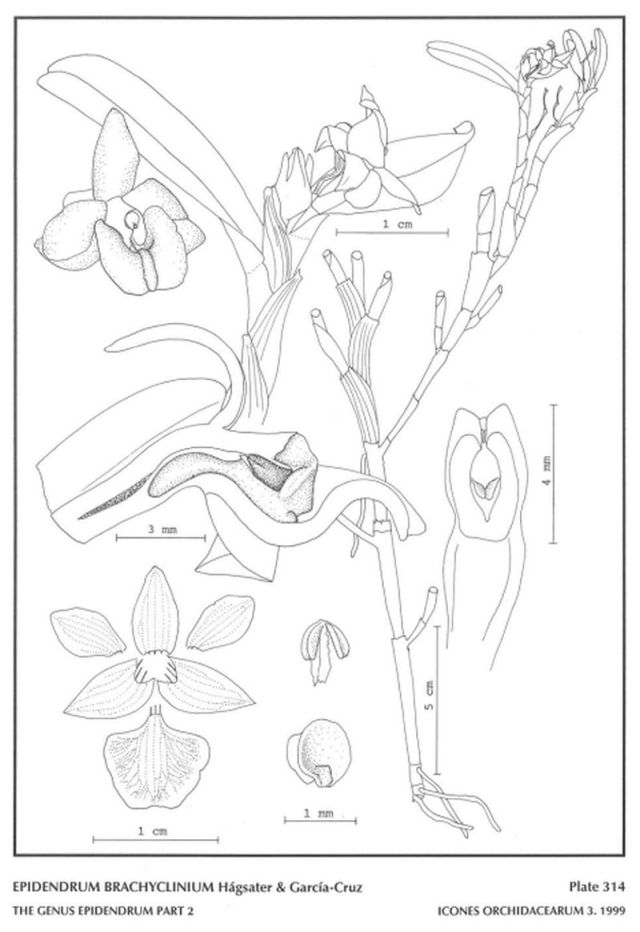

Epidendrum brachyclinium Hágsater & García-Cruz 1999 GROUP Ramosum SUBGROUP Platystigma
TYPE Drawing by © Jimenez, Hágsater & E.Santiago and The AMO Herbario Website




Common Name The Short Clinandrium Epidendrum [this species seems to have the shortest clinandrium of the platystima group]
Flower Size .8" [2 cm]
Found in Costa Rica in cloud forests and rain forests at elevations around 1460 to 2250 meters as a large sized, cool to cold growing epiphyte with branched, cane-like, terete stems carrying all along the young stem but when branching 1 to 2 towards the apex, oblong, obliquely bilobed apically leaves that blooms in the winter on a terminal, generally on the branches, flowering only once, racemose, distichous, erect, .2 to 1.2" [2 to 3 cm] long including the .12 to .2" [.3 to .5 cm] long peduncle, simultaneously 2 to 3 flowered inflorescence with a single, conduplicate, ovate, obtuse bract covering the peduncle and a much longer than the ovary, conduplicate, widely ovate, obtuse floral bract and carrying resupinate, green flowers that area sometimes tinged with purple.
The distinguishing features of this species are the large plant with small elliptic leaves, an inflorescence carrying 2 to 3 green, sometimes purple flowers with elliptic to sub-rhombic petals, an entire lip that is transversely obovate, basally cordate and apically truncate, the clinandrium is shorter than the body of the column and the ovary is straight.
"E. brachyclinium belongs to the GROUP Ramosum which is characterized by the monopodial, branching stems, the spike-like, distichous inflorescence, and the single callus, and the SUBGROUP Platystigma which has monopodial, erect plants with a clear primary stem, branching occurs from the axil of the leaves, producing short, few, small leaved branches, and these produce successive, short branches from a subapical internode, thus an old plant has numerous branches, these progressively made of fewer elements, and often lacking the juvenile, long leaves, at this stage the plant attains full flowering and often dies. and is recognized by its large plants with short, oblong leaves, secondary branches with leaves .6 to 1.4" x .2 to .4" [1.5 to 3.5 x 0.5 to 1 cm], flowers green, sometimes slightly purple, ovary straight, sepals ovate to elliptic, .12 to ..16" [3 to 4.5 mm] wide, petals subrhombic, lip entire, transversally ovate, base truncate, apex truncate, clinandrium reduced. E. acrostigma Hágsater & Carda-Cruz has secondary and tertiary branches with leaves 1.2 to 4.8" x .28 to .8" [3 to 12 x 0.7 to 2 cm], floral bracts .4 to .76" [1 to 1.9 cm] long, flower whitish green, lateral sepals strongly carinate, lip subquadrate, clinandrium short. E. campbelstigma Hágsater & Carda-Cruz has secondary branches with leaves 1.2 to 2.4" x .32 to .6" [3 to 6 x 0 .8 to 1.5 cm], the floral bracts widely ovate, flowers apple green, the lip white, subreniform." Hagsater etal 1999
Synonyms
References W3 Tropicos, Kew Monocot list , IPNI ; *Icones Orchidaceaum 3 Plate 314 Hagsater & Sanchez 1999 drawing fide; Manual de las Plantas de Costa Rica Vol 3 Hammel, Grayum, Herrera and Zamora 2003;
--------------------------------------------------------------------------------------------------------------------------